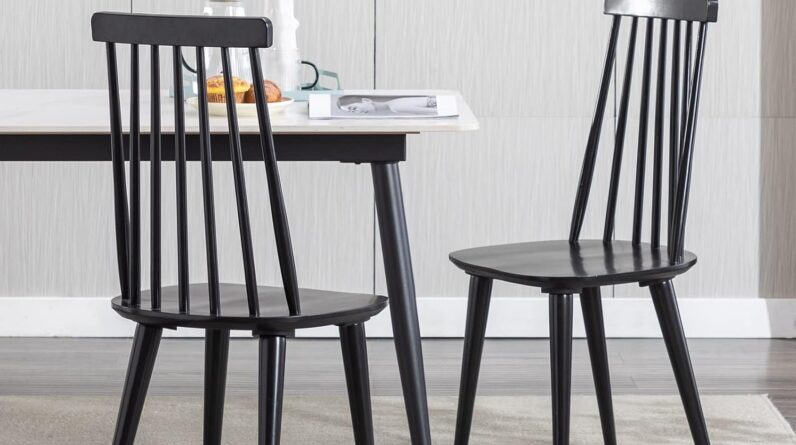
Imagine sitting down to a delicious meal with family and friends, surrounded by the perfect dining room ambiance. The food is delectable, the conversation is flowing, but there’s one crucial element that can make or break your dining experience: the comfort of your dining chairs.
In this comprehensive guide, we’ll explore the various dimensions to consider when selecting dining chairs, including seat height, seat width and depth, backrest height, armrest height, leg space, and overall dimensions. We’ll also delve into ergonomic considerations such as seat shape and contour, backrest angle, armrest design, and materials and padding. By the end of this article, you’ll have all the information you need to choose the perfect dining chairs for your space.
Seat Height
The seat height of your dining chairs plays a crucial role in providing comfort and proper posture. Standard seat height typically ranges between 17 to 19 inches. This height allows for most individuals to comfortably reach the table without feeling too high or too low. However, it’s essential to consider the height of your dining table when determining seat height.
For higher tables such as counters or bar areas, counter height or bar height chairs are recommended. Counter height chairs usually have a seat height of around 24 to 26 inches, while bar height chairs have a seat height of approximately 28 to 30 inches. Additionally, if you prefer adjustable height chairs, there are options available that allow you to customize the seat height to your preference.
Seat Width and Depth
The width and depth of the seat are other crucial factors to consider for optimal comfort. A comfortable seat width typically ranges between 16 to 20 inches. This width provides enough room for individuals to sit comfortably without feeling constrained.
In terms of seat depth, a depth of 16 to 18 inches is generally considered adequate. This depth allows for proper support and prevents individuals from feeling as if they’re sliding off the chair.
Backrest Height
Having an appropriately sized backrest is vital for providing support and promoting good posture. The height of the backrest should allow for comfortable back support while also being proportional to the overall chair dimensions.
Ideally, the backrest height should reach approximately halfway up the back, providing adequate lumbar support. This ensures proper alignment of the spine and prevents discomfort during extended periods of sitting. For added relaxation, some dining chairs also offer reclining backrests, allowing you to lean back comfortably.
Armrest Height
Armrests can enhance both comfort and functionality of dining chairs. The proper armrest height is essential to prevent strain on the shoulders and to allow for a relaxed sitting position. The armrest height should be around 7 to 9 inches above the seat level.
Additionally, considering the armrest width is essential, especially if you plan on placing the chairs close together. Ensure that the armrests do not obstruct movement or create discomfort when sitting.
For those who prefer a sleeker aesthetic or need to save space, armless dining chairs are an excellent option. Armless chairs provide more flexibility and can easily be pushed under the table when not in use.
Leg Space
Having sufficient leg space is crucial for comfort and ease of movement while seated. The distance between the seat and the floor should allow for an individual’s feet to rest comfortably flat on the ground. Additionally, leaving enough space between the chair and the table ensures that your legs have room to move freely without feeling trapped or cramped.
Considering the specific design of the chair legs is also important. Chairs with slim, tapered legs tend to offer more legroom compared to those with bulky or wide legs.
Overall Dimensions
Measuring the overall dimensions of a dining chair is essential to ensure it fits both your space and the table. The chair’s width should allow ample room for individuals to sit comfortably without feeling squeezed. A comfortable chair width typically ranges from 18 to 22 inches.
The chair’s depth should be enough to provide sufficient support while also allowing individuals to slide their chairs in and out without difficulty. A depth of around 16 to 20 inches generally works well for most dining spaces.
The chair’s height should be proportionate to the table height to ensure a natural seating position and comfortable reach. Additionally, considering the overall height of the chair is important if you have low ceilings or limited space above the table.
Seat Shape and Contour
Seat shape and contour greatly impact both the comfort and aesthetic appeal of dining chairs. Curved seats can provide extra comfort by contouring to the shape of the body, reducing pressure points and promoting better posture.
Winged backrests are another popular option for added support and comfort. These backrests extend slightly forward, providing support and preventing individuals from slouching.
Ergonomic padding can also enhance the comfort of dining chairs. Cushioned seats offer a soft surface to sit on, while materials such as memory foam provide additional support and adapt to the shape of the body.
Materials and Padding
Choosing the right materials and padding for your dining chairs is crucial for both comfort and durability. Cushioned seats provide extra comfort, especially for extended periods of sitting. Look for chairs with high-quality padding that will retain its shape over time.
Breathable fabrics, such as cotton or linen upholstery, are also ideal for dining chairs. These materials allow air to circulate, preventing discomfort caused by heat buildup.
Opting for durable upholstery that is easy to clean and maintain is also important, as dining chairs are prone to spills and stains. Consider materials that are stain-resistant or easily washable for a longer-lasting and aesthetically pleasing dining chair.
In conclusion, choosing the most comfortable dining chair dimensions requires careful consideration of seat height, seat width and depth, backrest height, armrest height, leg space, and overall dimensions. Ergonomic aspects such as seat shape and contour, backrest angle, armrest design, and materials and padding also play a significant role in providing optimal comfort. By using this comprehensive guide, you can confidently select dining chairs that not only enhance your dining experience but also add style and functionality to your space. So go ahead and find the perfect dining chairs that will ensure every meal is a comfortable and enjoyable experience for you and your loved ones.







